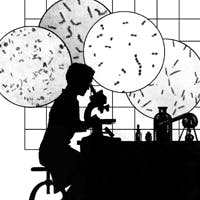Perhaps no other instrument in the medical laboratory commands as much attention as the microscope. It remains the centerpiece of every department and is at the core of all specimen visualizations. And while microscope manufacturers tout new products with all the latest technological and ergonomic features, many labs still rely on older models to do a variety of day-to-day tasks. Here are some reasons why.
High-volume testing
For-profit reference lab, Life Laboratories (Springfield, MA) runs two shifts in its microbiology department and has a staff of 20 technologists and technicians, according to Sharon Smith, microbiology manager. The department has seven microscopes, including a new Olympus BX43, recently purchased with grant money. Smith says the other scopes — three Olympus BX41s, an Olympus BH2, and two old compound microscopes from American Optical (AO) — are the lab’s workhorses. Two BX41s are on the bench and are used mainly for Gram stains and stool samples, and to run ova parasite tests. Another BX41 is primarily used for specimen prep, wet mounts, and Gram stains. “One BX41 has a camera attached,” says Smith, adding that photos are taken of anything that looks unusual and as a quality-control measure when doing CAP-accreditation surveys. Smith also says that with the arrival of the new Olympus, one of the old AOs will be retired; the other one will still be used for simple tasks like studying fungus cultures.
Interestingly, an old AO110 Microstar is still being used to test urine samples at the 120-bed Avera Queen of Peace Hospital (Mitchell, SD) says Paula Swanson, microbiology supervisor. Her department uses a Nikon E400 for Gram stains, while the hematology department uses an Olympus BX40 to run differentials and to do semen analyses.
Barbara Laware, a medical technologist also at Life Laboratories, says the immunology department has an Olympus BX41 fitted with a fluorescence attachment. This scope is used to perform the antinuclear antibodies test, looking for a specific protein associated with miscarriages and infertility. Laware says the hematology department uses three Nikon E400s to run differentials and to check urine samples for blood cells, crystals, and sediments. In addition, Life Laboratories also has one clinical pathologist and five anatomical pathologists on staff, each with his own microscope.
Laboratory Alliance (Liverpool, NY) is a not-for-profit lab owned by three hospitals in Syracuse. While each hospital has its own lab, Lab Alliance does more of the esoteric testing, says Anne Chamberlain, the hematology manager. In her department, there are five microscopes: an Olympus CH30, an Olympus BH2, a Nikon E400 and E50i, and an old AO110. “The AO is used to do differentials,” she says. “The BH2 is used for body-fluid chamber counts and sperm counts. And the CH30 is used for urine samples.” Chamberlain hopes to replace the older Olympus with a Nikon E55i and to fit the E50i with a camera.
Physician-based tests
Family Health Associates (Chippewa Falls, WI) is a physician practice with five physicians and one nurse practitioner. The lab has a staff of six — four technicians, one technologist, and one phlebotomist — with only one microscope, an Olympus CH30, that is used for all in-house tests, says Lynn Boos, the lab supervisor. Using that one scope, the lab regularly does wet mounts, manual differentials, Gram stains, and urine tests. Other tests done include the Fern test to check for amniotic fluid, post-vasectomy sperm counts, and the study of skin scrapings for fungal infections.
Oakhill Medical Associates (West Liberty, OH) is comprised of two physician practices under one roof — one with four physicians, the other with four physicians and a nurse practitioner. Because it is associated with Ohio State University, Oakhill Medical Associates gets its fair share of rotating residents. Brenda Haley, laboratory supervisor, says the lab is staffed by two medical technologists and a phlebotomist who share an old dual-eyepiece Zeiss microscope. The majority of testing done with this scope deals with urine samples — looking for red or white blood cells, crystals, and sediment —and it is sometimes used for wet mounts and for skin scrapings. “Any differentials are sent out to a reference lab, as are Gram stains,” says Haley.
Inpatient testing
The 290-bed Prince Georges Hospital Center (Cheverly, MD) has a 75-member lab staff that includes two pathologists for each shift, says Jeanne Colfack, the lab manager. The eight Nikon E400 lab microscopes are used for all hematology, microbiology, and chemistry studies. The pathologists’ microscope has a camera attached so surgical slides can be filed with each report.
For the 40 clinical lab scientists and six pathologists who staff the lab at the 180-bed Kaiser Permanente Hospital (Hayward, CA) four microscopes are in the lab — one fitted with a camera. According to Rosalind Wallace, lab director, an Olympus BX41 is used mainly for Gram stains, an Olympus CH30 for urine testing, and two Olympus BX40s for differentials.
At Pender Community Hospital (Pender, NE), four full-time medical technologists share two microscopes, says Don Pearson, the lab supervisor. An Olympus BX45 with an attached camera is used largely for Gram stains, while an AO110 Microstar is primarily used for urine tests. Pearson does not know exactly when the lab purchased the AO scope, but he says, “That Microstar has been here longer than I have, and I have been here 30 years.”
Size matters little in microscope choices
Mitchell County Hospital (Beloit, KS) a 25-bed critical-access hospital boasts a lab staff of seven technologists and three assistants, says Jolene Albert, lab supervisor. Two Nikon E400s are used for differentials and Gram stains, while an Olympus BX41 is used for visualizing urine samples.
The 165-bed Queen of the Valley Hospital (Napa, CA) has 12 lab microscopes, three in hematology, says Mary Ellsworth, that department’s supervisor. Three full-time techs use two Nikon E400s, as well as a Nikon E50i. “We do differentials, urinalyses, manual fluid counts, manual semen analyses, and the occasional malaria test, One camera attached for photos of abnormal cells for the pathologist’s review.”
Ed Faralan, a clinical research scientist in the hematology department of Valley Presbyterian Hospital (Van Nuys, CA) says this 350-bed hospital has a six-department lab. In his department, the six clinical-research scientists who staff three shifts, use a Nikon E400 and a Nikon Labophot-2 to do a wide variety of tasks, including differentials, urinalyses, and testing for fetal blood.
Richard R. Rogoski ([email protected]) is a freelance journalist based in Durham, NC.


